Report: Business Project Management for British Telecom Company
VerifiedAdded on 2021/01/02
|26
|4637
|455
Report
AI Summary
This report delves into the management of a successful business project, specifically focusing on British Telecom. It begins by outlining the aims and objectives of the research, which centers on understanding the impact of globalization on the company's operations. The report then presents a detailed project management plan, including cost estimations, timelines, and risk assessments. A work breakdown structure and Gantt chart are provided to illustrate the project's organization and schedule. The research methodology, including primary and secondary research methods, along with quantitative and qualitative approaches, is discussed. Data analysis, including the results of a survey on globalization awareness, is also included. The report concludes with recommendations and a reflection on the research process, providing a comprehensive overview of managing a business project in a globalized context.
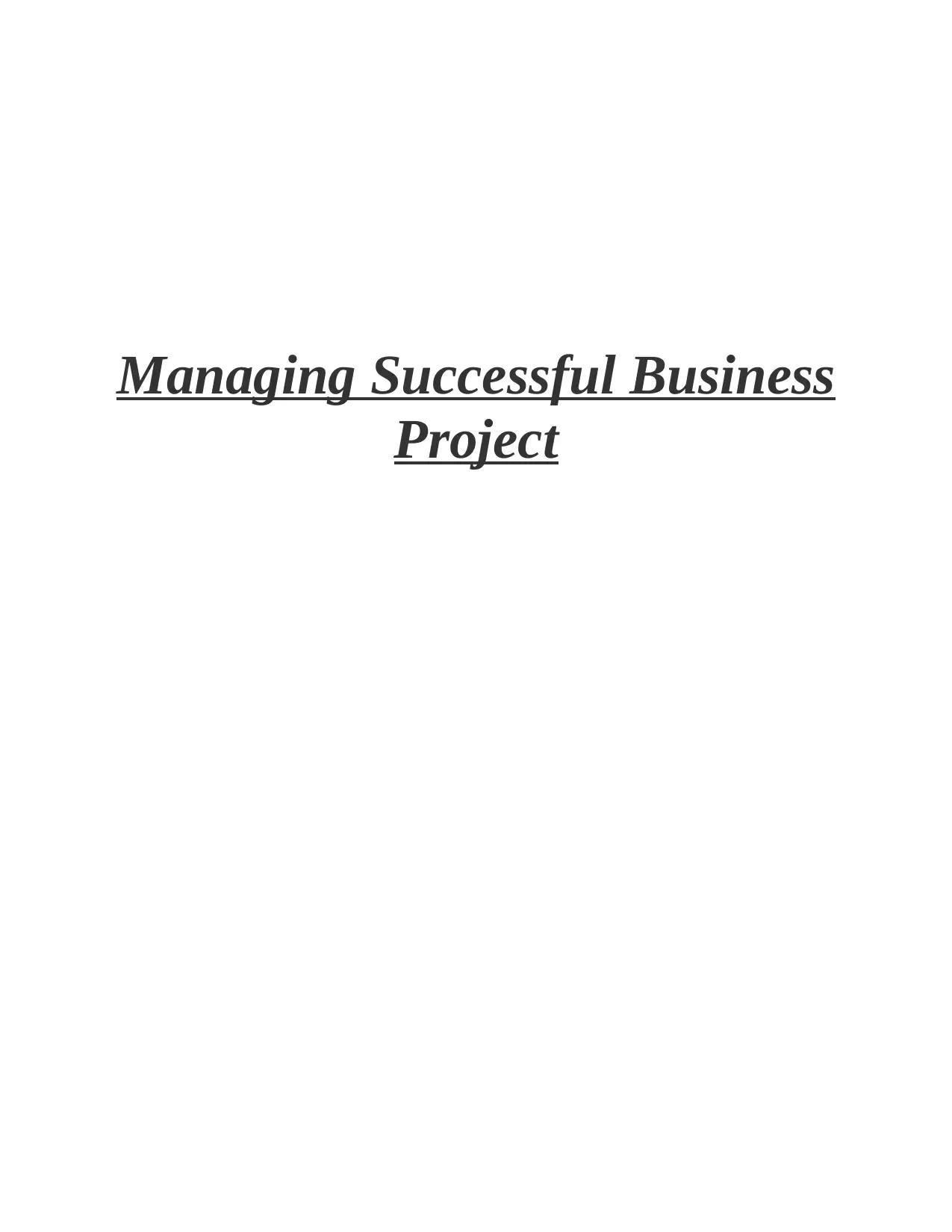
Managing Successful Business
Project
Project
Paraphrase This Document
Need a fresh take? Get an instant paraphrase of this document with our AI Paraphraser
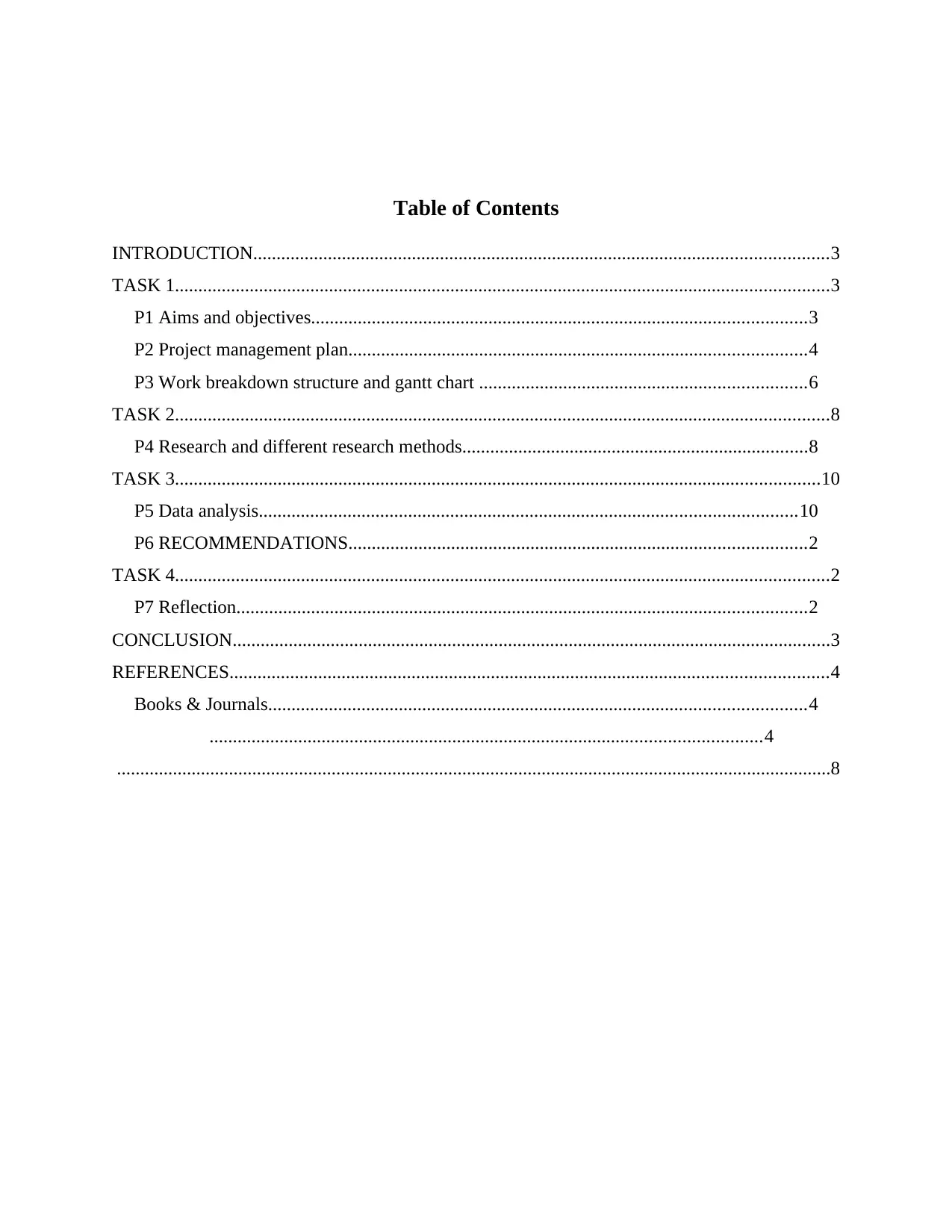
Table of Contents
INTRODUCTION...........................................................................................................................3
TASK 1............................................................................................................................................3
P1 Aims and objectives..........................................................................................................3
P2 Project management plan..................................................................................................4
P3 Work breakdown structure and gantt chart ......................................................................6
TASK 2............................................................................................................................................8
P4 Research and different research methods..........................................................................8
TASK 3..........................................................................................................................................10
P5 Data analysis...................................................................................................................10
P6 RECOMMENDATIONS..................................................................................................2
TASK 4............................................................................................................................................2
P7 Reflection..........................................................................................................................2
CONCLUSION................................................................................................................................3
REFERENCES................................................................................................................................4
Books & Journals...................................................................................................................4
......................................................................................................................4
.........................................................................................................................................................8
INTRODUCTION...........................................................................................................................3
TASK 1............................................................................................................................................3
P1 Aims and objectives..........................................................................................................3
P2 Project management plan..................................................................................................4
P3 Work breakdown structure and gantt chart ......................................................................6
TASK 2............................................................................................................................................8
P4 Research and different research methods..........................................................................8
TASK 3..........................................................................................................................................10
P5 Data analysis...................................................................................................................10
P6 RECOMMENDATIONS..................................................................................................2
TASK 4............................................................................................................................................2
P7 Reflection..........................................................................................................................2
CONCLUSION................................................................................................................................3
REFERENCES................................................................................................................................4
Books & Journals...................................................................................................................4
......................................................................................................................4
.........................................................................................................................................................8
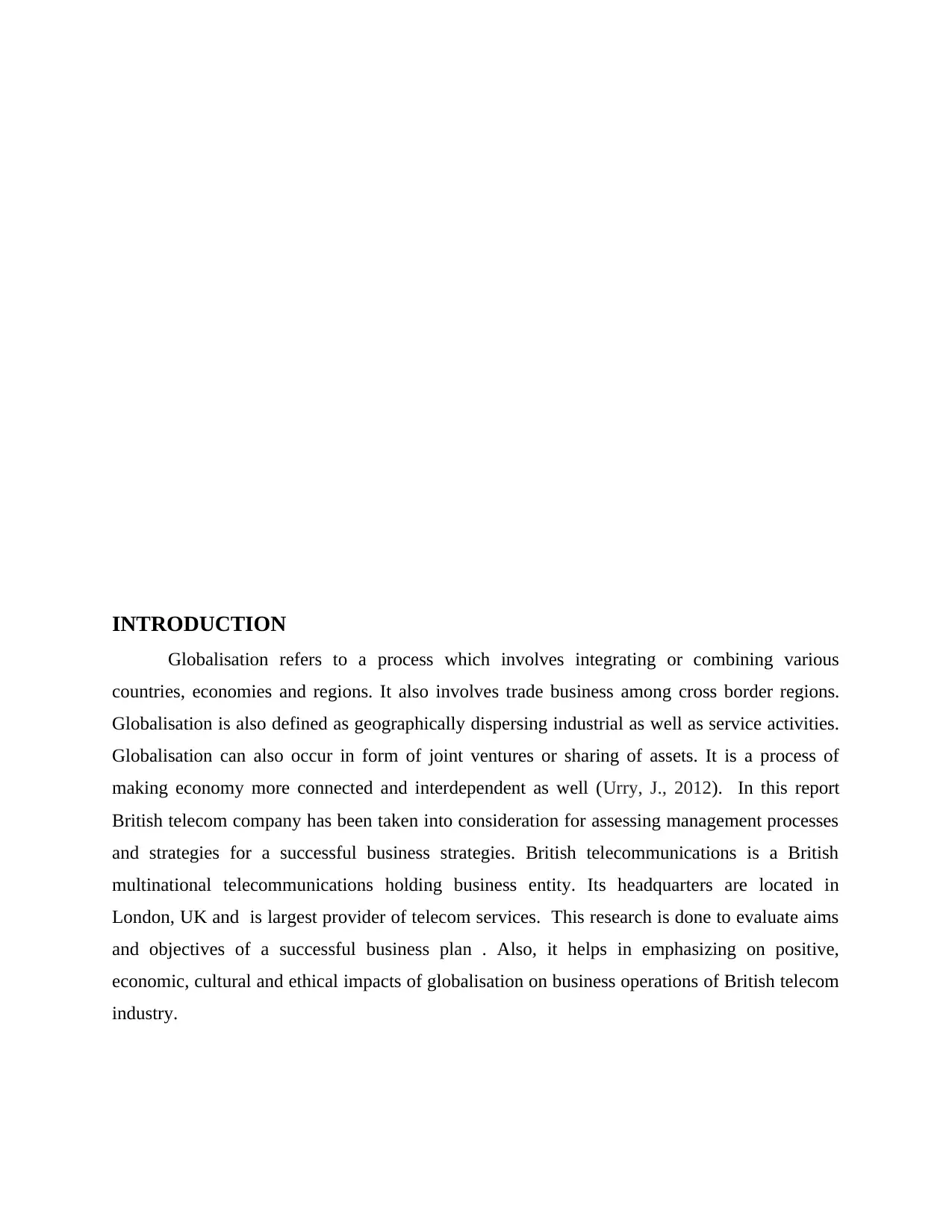
INTRODUCTION
Globalisation refers to a process which involves integrating or combining various
countries, economies and regions. It also involves trade business among cross border regions.
Globalisation is also defined as geographically dispersing industrial as well as service activities.
Globalisation can also occur in form of joint ventures or sharing of assets. It is a process of
making economy more connected and interdependent as well (Urry, J., 2012). In this report
British telecom company has been taken into consideration for assessing management processes
and strategies for a successful business strategies. British telecommunications is a British
multinational telecommunications holding business entity. Its headquarters are located in
London, UK and is largest provider of telecom services. This research is done to evaluate aims
and objectives of a successful business plan . Also, it helps in emphasizing on positive,
economic, cultural and ethical impacts of globalisation on business operations of British telecom
industry.
Globalisation refers to a process which involves integrating or combining various
countries, economies and regions. It also involves trade business among cross border regions.
Globalisation is also defined as geographically dispersing industrial as well as service activities.
Globalisation can also occur in form of joint ventures or sharing of assets. It is a process of
making economy more connected and interdependent as well (Urry, J., 2012). In this report
British telecom company has been taken into consideration for assessing management processes
and strategies for a successful business strategies. British telecommunications is a British
multinational telecommunications holding business entity. Its headquarters are located in
London, UK and is largest provider of telecom services. This research is done to evaluate aims
and objectives of a successful business plan . Also, it helps in emphasizing on positive,
economic, cultural and ethical impacts of globalisation on business operations of British telecom
industry.
⊘ This is a preview!⊘
Do you want full access?
Subscribe today to unlock all pages.

Trusted by 1+ million students worldwide
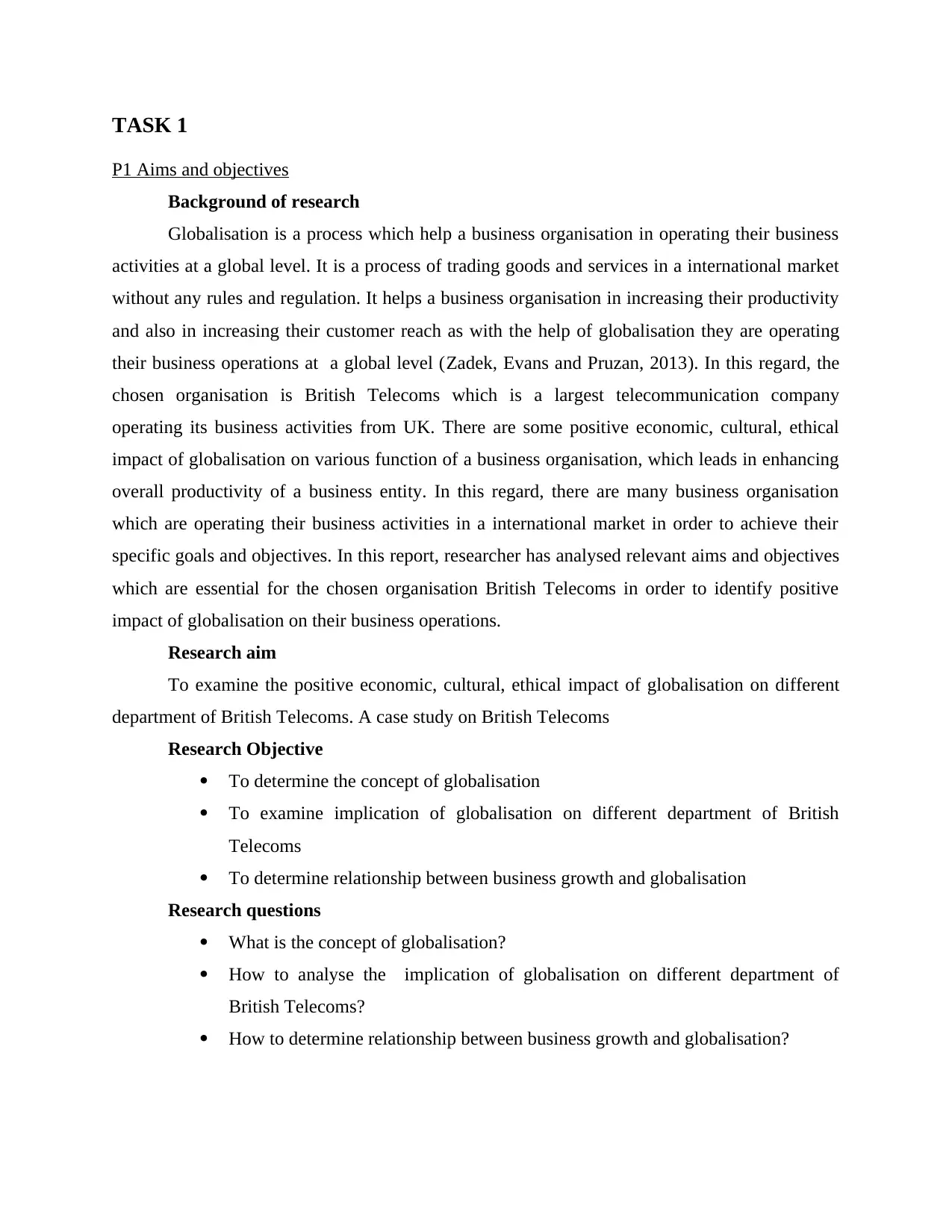
TASK 1
P1 Aims and objectives
Background of research
Globalisation is a process which help a business organisation in operating their business
activities at a global level. It is a process of trading goods and services in a international market
without any rules and regulation. It helps a business organisation in increasing their productivity
and also in increasing their customer reach as with the help of globalisation they are operating
their business operations at a global level (Zadek, Evans and Pruzan, 2013). In this regard, the
chosen organisation is British Telecoms which is a largest telecommunication company
operating its business activities from UK. There are some positive economic, cultural, ethical
impact of globalisation on various function of a business organisation, which leads in enhancing
overall productivity of a business entity. In this regard, there are many business organisation
which are operating their business activities in a international market in order to achieve their
specific goals and objectives. In this report, researcher has analysed relevant aims and objectives
which are essential for the chosen organisation British Telecoms in order to identify positive
impact of globalisation on their business operations.
Research aim
To examine the positive economic, cultural, ethical impact of globalisation on different
department of British Telecoms. A case study on British Telecoms
Research Objective
To determine the concept of globalisation
To examine implication of globalisation on different department of British
Telecoms
To determine relationship between business growth and globalisation
Research questions
What is the concept of globalisation?
How to analyse the implication of globalisation on different department of
British Telecoms?
How to determine relationship between business growth and globalisation?
P1 Aims and objectives
Background of research
Globalisation is a process which help a business organisation in operating their business
activities at a global level. It is a process of trading goods and services in a international market
without any rules and regulation. It helps a business organisation in increasing their productivity
and also in increasing their customer reach as with the help of globalisation they are operating
their business operations at a global level (Zadek, Evans and Pruzan, 2013). In this regard, the
chosen organisation is British Telecoms which is a largest telecommunication company
operating its business activities from UK. There are some positive economic, cultural, ethical
impact of globalisation on various function of a business organisation, which leads in enhancing
overall productivity of a business entity. In this regard, there are many business organisation
which are operating their business activities in a international market in order to achieve their
specific goals and objectives. In this report, researcher has analysed relevant aims and objectives
which are essential for the chosen organisation British Telecoms in order to identify positive
impact of globalisation on their business operations.
Research aim
To examine the positive economic, cultural, ethical impact of globalisation on different
department of British Telecoms. A case study on British Telecoms
Research Objective
To determine the concept of globalisation
To examine implication of globalisation on different department of British
Telecoms
To determine relationship between business growth and globalisation
Research questions
What is the concept of globalisation?
How to analyse the implication of globalisation on different department of
British Telecoms?
How to determine relationship between business growth and globalisation?
Paraphrase This Document
Need a fresh take? Get an instant paraphrase of this document with our AI Paraphraser
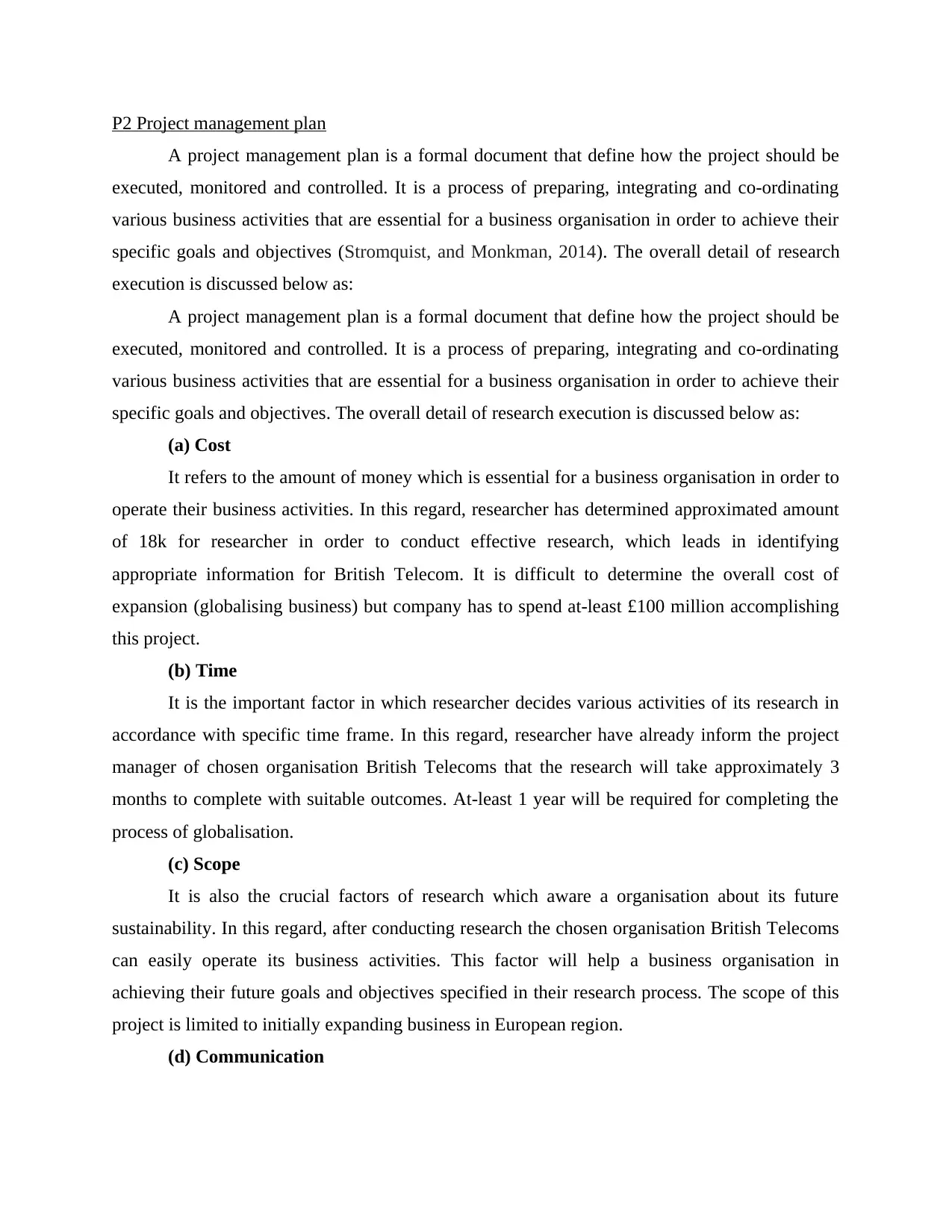
P2 Project management plan
A project management plan is a formal document that define how the project should be
executed, monitored and controlled. It is a process of preparing, integrating and co-ordinating
various business activities that are essential for a business organisation in order to achieve their
specific goals and objectives (Stromquist, and Monkman, 2014). The overall detail of research
execution is discussed below as:
A project management plan is a formal document that define how the project should be
executed, monitored and controlled. It is a process of preparing, integrating and co-ordinating
various business activities that are essential for a business organisation in order to achieve their
specific goals and objectives. The overall detail of research execution is discussed below as:
(a) Cost
It refers to the amount of money which is essential for a business organisation in order to
operate their business activities. In this regard, researcher has determined approximated amount
of 18k for researcher in order to conduct effective research, which leads in identifying
appropriate information for British Telecom. It is difficult to determine the overall cost of
expansion (globalising business) but company has to spend at-least £100 million accomplishing
this project.
(b) Time
It is the important factor in which researcher decides various activities of its research in
accordance with specific time frame. In this regard, researcher have already inform the project
manager of chosen organisation British Telecoms that the research will take approximately 3
months to complete with suitable outcomes. At-least 1 year will be required for completing the
process of globalisation.
(c) Scope
It is also the crucial factors of research which aware a organisation about its future
sustainability. In this regard, after conducting research the chosen organisation British Telecoms
can easily operate its business activities. This factor will help a business organisation in
achieving their future goals and objectives specified in their research process. The scope of this
project is limited to initially expanding business in European region.
(d) Communication
A project management plan is a formal document that define how the project should be
executed, monitored and controlled. It is a process of preparing, integrating and co-ordinating
various business activities that are essential for a business organisation in order to achieve their
specific goals and objectives (Stromquist, and Monkman, 2014). The overall detail of research
execution is discussed below as:
A project management plan is a formal document that define how the project should be
executed, monitored and controlled. It is a process of preparing, integrating and co-ordinating
various business activities that are essential for a business organisation in order to achieve their
specific goals and objectives. The overall detail of research execution is discussed below as:
(a) Cost
It refers to the amount of money which is essential for a business organisation in order to
operate their business activities. In this regard, researcher has determined approximated amount
of 18k for researcher in order to conduct effective research, which leads in identifying
appropriate information for British Telecom. It is difficult to determine the overall cost of
expansion (globalising business) but company has to spend at-least £100 million accomplishing
this project.
(b) Time
It is the important factor in which researcher decides various activities of its research in
accordance with specific time frame. In this regard, researcher have already inform the project
manager of chosen organisation British Telecoms that the research will take approximately 3
months to complete with suitable outcomes. At-least 1 year will be required for completing the
process of globalisation.
(c) Scope
It is also the crucial factors of research which aware a organisation about its future
sustainability. In this regard, after conducting research the chosen organisation British Telecoms
can easily operate its business activities. This factor will help a business organisation in
achieving their future goals and objectives specified in their research process. The scope of this
project is limited to initially expanding business in European region.
(d) Communication
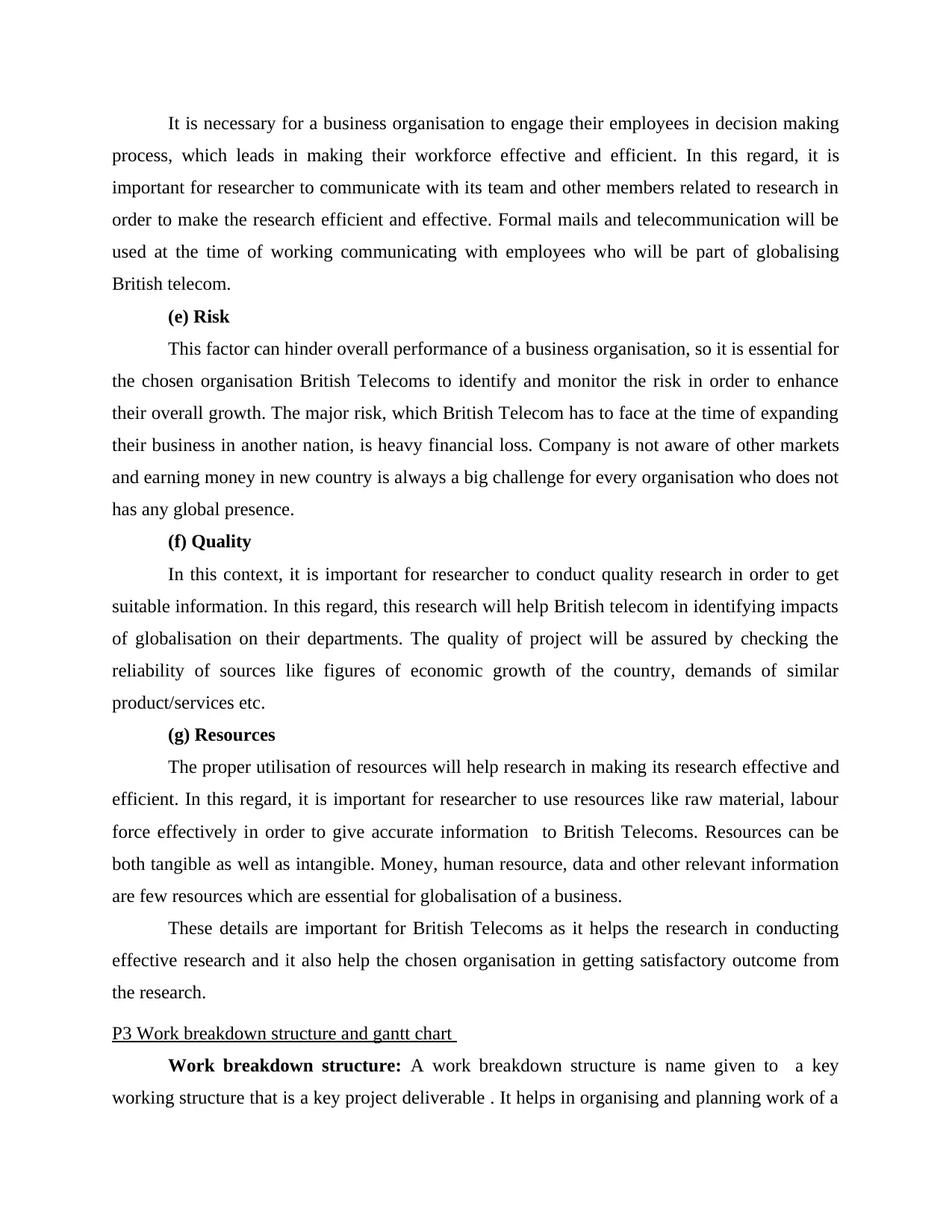
It is necessary for a business organisation to engage their employees in decision making
process, which leads in making their workforce effective and efficient. In this regard, it is
important for researcher to communicate with its team and other members related to research in
order to make the research efficient and effective. Formal mails and telecommunication will be
used at the time of working communicating with employees who will be part of globalising
British telecom.
(e) Risk
This factor can hinder overall performance of a business organisation, so it is essential for
the chosen organisation British Telecoms to identify and monitor the risk in order to enhance
their overall growth. The major risk, which British Telecom has to face at the time of expanding
their business in another nation, is heavy financial loss. Company is not aware of other markets
and earning money in new country is always a big challenge for every organisation who does not
has any global presence.
(f) Quality
In this context, it is important for researcher to conduct quality research in order to get
suitable information. In this regard, this research will help British telecom in identifying impacts
of globalisation on their departments. The quality of project will be assured by checking the
reliability of sources like figures of economic growth of the country, demands of similar
product/services etc.
(g) Resources
The proper utilisation of resources will help research in making its research effective and
efficient. In this regard, it is important for researcher to use resources like raw material, labour
force effectively in order to give accurate information to British Telecoms. Resources can be
both tangible as well as intangible. Money, human resource, data and other relevant information
are few resources which are essential for globalisation of a business.
These details are important for British Telecoms as it helps the research in conducting
effective research and it also help the chosen organisation in getting satisfactory outcome from
the research.
P3 Work breakdown structure and gantt chart
Work breakdown structure: A work breakdown structure is name given to a key
working structure that is a key project deliverable . It helps in organising and planning work of a
process, which leads in making their workforce effective and efficient. In this regard, it is
important for researcher to communicate with its team and other members related to research in
order to make the research efficient and effective. Formal mails and telecommunication will be
used at the time of working communicating with employees who will be part of globalising
British telecom.
(e) Risk
This factor can hinder overall performance of a business organisation, so it is essential for
the chosen organisation British Telecoms to identify and monitor the risk in order to enhance
their overall growth. The major risk, which British Telecom has to face at the time of expanding
their business in another nation, is heavy financial loss. Company is not aware of other markets
and earning money in new country is always a big challenge for every organisation who does not
has any global presence.
(f) Quality
In this context, it is important for researcher to conduct quality research in order to get
suitable information. In this regard, this research will help British telecom in identifying impacts
of globalisation on their departments. The quality of project will be assured by checking the
reliability of sources like figures of economic growth of the country, demands of similar
product/services etc.
(g) Resources
The proper utilisation of resources will help research in making its research effective and
efficient. In this regard, it is important for researcher to use resources like raw material, labour
force effectively in order to give accurate information to British Telecoms. Resources can be
both tangible as well as intangible. Money, human resource, data and other relevant information
are few resources which are essential for globalisation of a business.
These details are important for British Telecoms as it helps the research in conducting
effective research and it also help the chosen organisation in getting satisfactory outcome from
the research.
P3 Work breakdown structure and gantt chart
Work breakdown structure: A work breakdown structure is name given to a key
working structure that is a key project deliverable . It helps in organising and planning work of a
⊘ This is a preview!⊘
Do you want full access?
Subscribe today to unlock all pages.

Trusted by 1+ million students worldwide
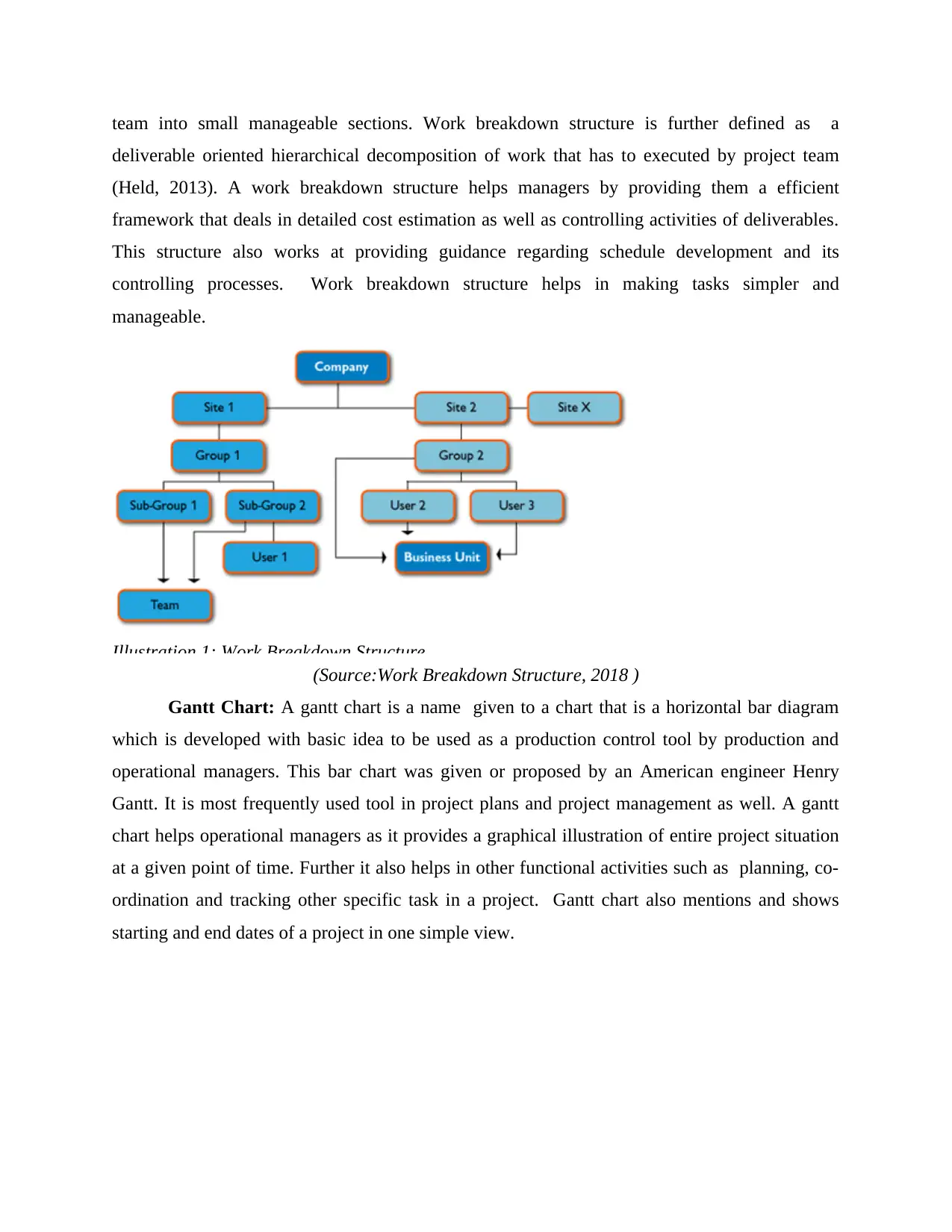
team into small manageable sections. Work breakdown structure is further defined as a
deliverable oriented hierarchical decomposition of work that has to executed by project team
(Held, 2013). A work breakdown structure helps managers by providing them a efficient
framework that deals in detailed cost estimation as well as controlling activities of deliverables.
This structure also works at providing guidance regarding schedule development and its
controlling processes. Work breakdown structure helps in making tasks simpler and
manageable.
Illustration 1: Work Breakdown Structure
(Source:Work Breakdown Structure, 2018 )
Gantt Chart: A gantt chart is a name given to a chart that is a horizontal bar diagram
which is developed with basic idea to be used as a production control tool by production and
operational managers. This bar chart was given or proposed by an American engineer Henry
Gantt. It is most frequently used tool in project plans and project management as well. A gantt
chart helps operational managers as it provides a graphical illustration of entire project situation
at a given point of time. Further it also helps in other functional activities such as planning, co-
ordination and tracking other specific task in a project. Gantt chart also mentions and shows
starting and end dates of a project in one simple view.
deliverable oriented hierarchical decomposition of work that has to executed by project team
(Held, 2013). A work breakdown structure helps managers by providing them a efficient
framework that deals in detailed cost estimation as well as controlling activities of deliverables.
This structure also works at providing guidance regarding schedule development and its
controlling processes. Work breakdown structure helps in making tasks simpler and
manageable.
Illustration 1: Work Breakdown Structure
(Source:Work Breakdown Structure, 2018 )
Gantt Chart: A gantt chart is a name given to a chart that is a horizontal bar diagram
which is developed with basic idea to be used as a production control tool by production and
operational managers. This bar chart was given or proposed by an American engineer Henry
Gantt. It is most frequently used tool in project plans and project management as well. A gantt
chart helps operational managers as it provides a graphical illustration of entire project situation
at a given point of time. Further it also helps in other functional activities such as planning, co-
ordination and tracking other specific task in a project. Gantt chart also mentions and shows
starting and end dates of a project in one simple view.
Paraphrase This Document
Need a fresh take? Get an instant paraphrase of this document with our AI Paraphraser
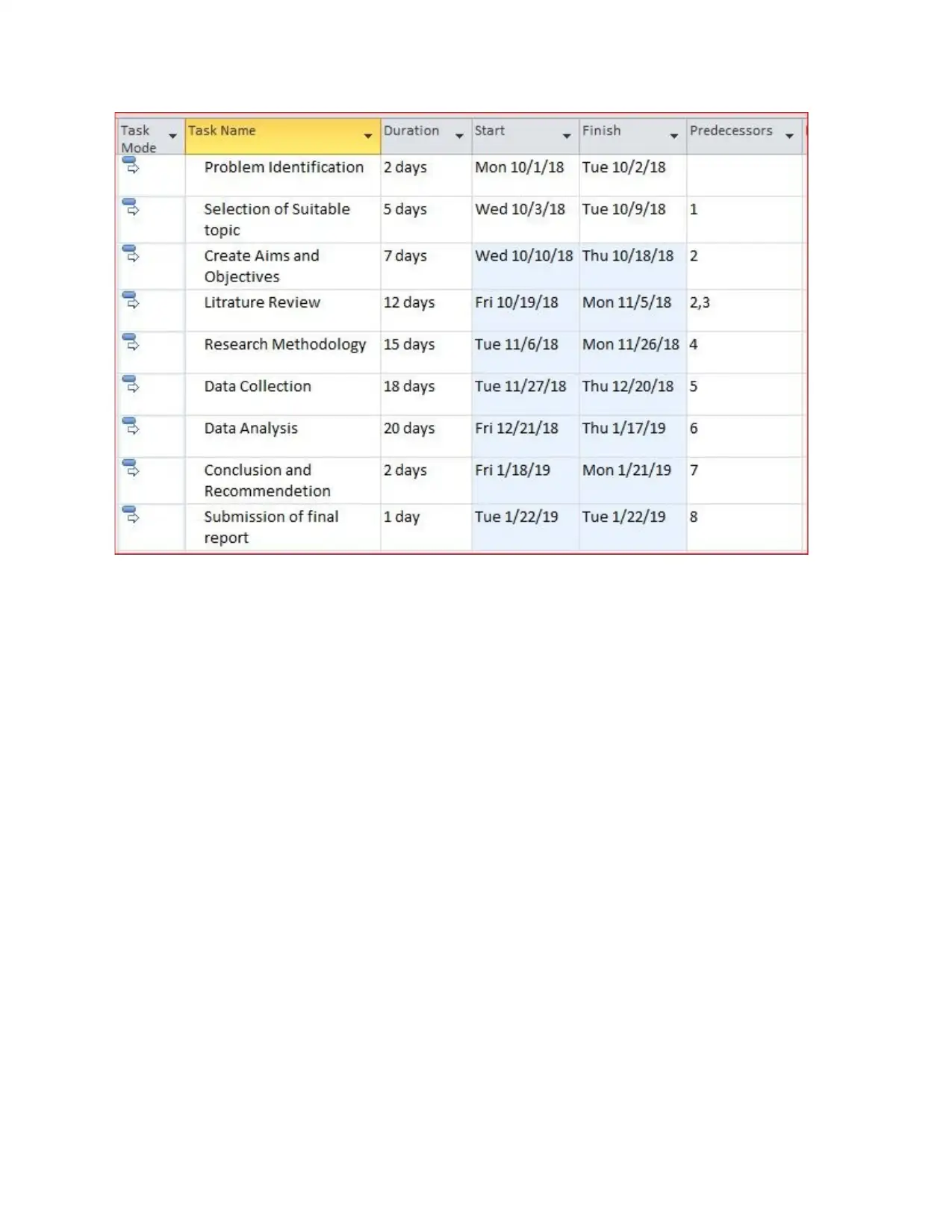
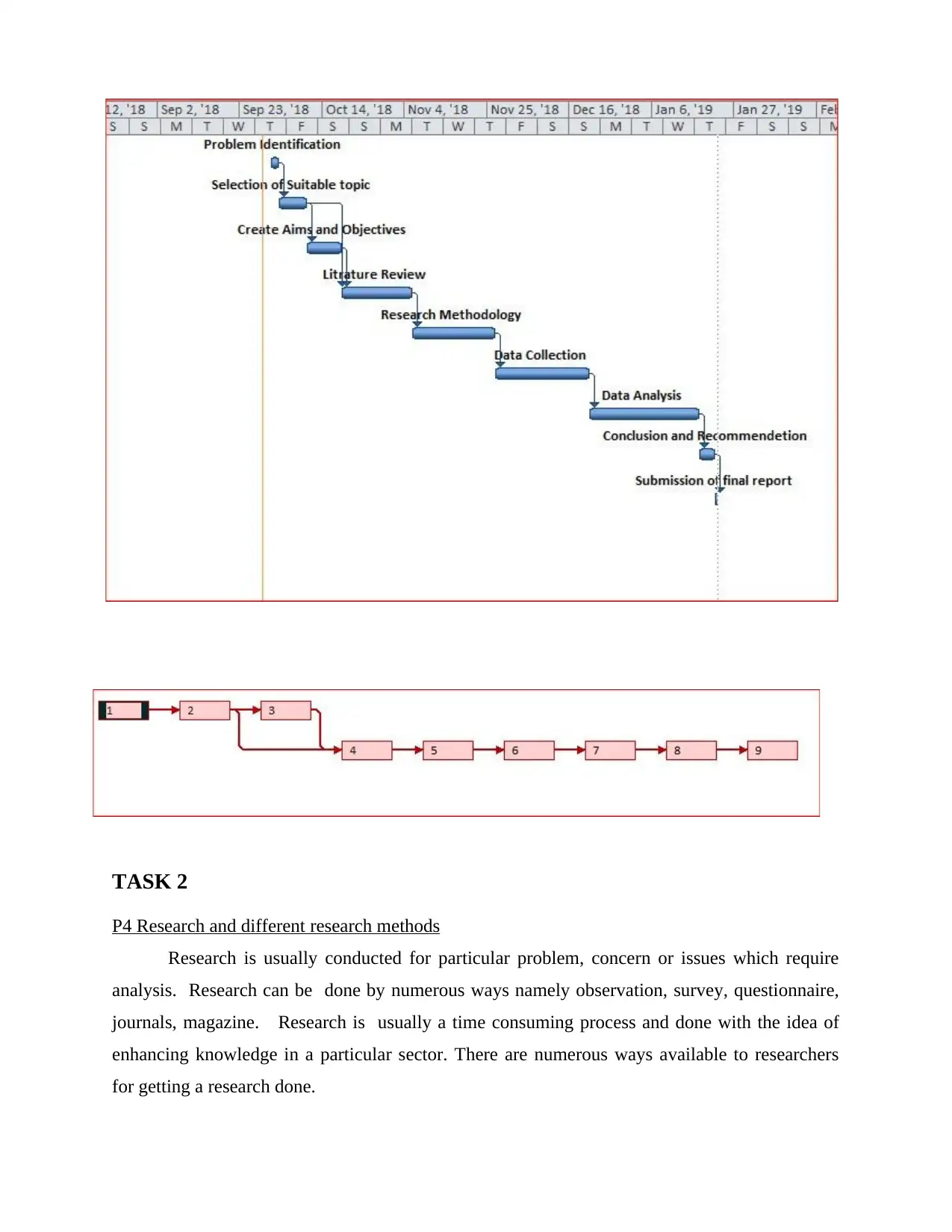
TASK 2
P4 Research and different research methods
Research is usually conducted for particular problem, concern or issues which require
analysis. Research can be done by numerous ways namely observation, survey, questionnaire,
journals, magazine. Research is usually a time consuming process and done with the idea of
enhancing knowledge in a particular sector. There are numerous ways available to researchers
for getting a research done.
P4 Research and different research methods
Research is usually conducted for particular problem, concern or issues which require
analysis. Research can be done by numerous ways namely observation, survey, questionnaire,
journals, magazine. Research is usually a time consuming process and done with the idea of
enhancing knowledge in a particular sector. There are numerous ways available to researchers
for getting a research done.
⊘ This is a preview!⊘
Do you want full access?
Subscribe today to unlock all pages.

Trusted by 1+ million students worldwide

Primary research method
Primary research is a direct form of research,. It is done by researchers by taking help of
questionnaires, surveys, interviews of an individual and small group of people. This research is
done by directly interviewing individuals and data collected is also true and fair (Webster,
2014). Data collected by researchers under this method is never taken from any other source or
copied from anywhere.
It is a type of market research which is usually done by business concerns'. Main aim of this
research is to improve quality of products and services. It is a research that begins directly from a
scratch. This method is used only when direct and specific issues are involved in a research.
Secondary research method
Secondary research method is totally opposite of primary method. It does not involve
collecting data right from beginning or scratch rather relies on information that that is already
available from various sources. This method of conducting research is a time and cost effective
method and uses less number of resources. Main focus of this research relies on data that has
been already collected by other people and is easily available for use (Cooke, 2012). The
secondary research data is collected through the newspaper, journals, magazines. This data is
already gathered and assemble by the experts in the form of reports and studies. Sometimes
information is available on internet also .
Quantitative research methods
This research is based on statistical and numeric analysis of data. data is usually
collected through questionnaires and surveys that are easily available in market. Close-ended
process is followed while doing quantitative research. Information can be gathered by
manipulating existing data a little bit or entirely replacing it. Data or facts collected under this
method are entirely in a structured form (Gopalakrishnan and et. al., 2012). This research is
based on large size of sample. They have depreciative, correlation, quasi-experimental as well as
experimental design in this method.
Quantitative research method has hard facts and statistical data involved rather than qualitative
identities like expressions, feelings and opinions of customers. This method applies to both
primary as well as secondary research.
Qualitative research methods
Primary research is a direct form of research,. It is done by researchers by taking help of
questionnaires, surveys, interviews of an individual and small group of people. This research is
done by directly interviewing individuals and data collected is also true and fair (Webster,
2014). Data collected by researchers under this method is never taken from any other source or
copied from anywhere.
It is a type of market research which is usually done by business concerns'. Main aim of this
research is to improve quality of products and services. It is a research that begins directly from a
scratch. This method is used only when direct and specific issues are involved in a research.
Secondary research method
Secondary research method is totally opposite of primary method. It does not involve
collecting data right from beginning or scratch rather relies on information that that is already
available from various sources. This method of conducting research is a time and cost effective
method and uses less number of resources. Main focus of this research relies on data that has
been already collected by other people and is easily available for use (Cooke, 2012). The
secondary research data is collected through the newspaper, journals, magazines. This data is
already gathered and assemble by the experts in the form of reports and studies. Sometimes
information is available on internet also .
Quantitative research methods
This research is based on statistical and numeric analysis of data. data is usually
collected through questionnaires and surveys that are easily available in market. Close-ended
process is followed while doing quantitative research. Information can be gathered by
manipulating existing data a little bit or entirely replacing it. Data or facts collected under this
method are entirely in a structured form (Gopalakrishnan and et. al., 2012). This research is
based on large size of sample. They have depreciative, correlation, quasi-experimental as well as
experimental design in this method.
Quantitative research method has hard facts and statistical data involved rather than qualitative
identities like expressions, feelings and opinions of customers. This method applies to both
primary as well as secondary research.
Qualitative research methods
Paraphrase This Document
Need a fresh take? Get an instant paraphrase of this document with our AI Paraphraser

Qualitative form of market research is a type of market research that majorly involves
opinions and feelings of a customer as far as products and services of a business entity are
concerned. There are numerous examples of qualitative research namely conducting of face to
face interviews, being part of focus groups and so on. This research method emphasizes on
qualitative aspects and completely ignores quantitative aspects such as facts and figures and so
on.
TASK 3
P5 Data analysis
Q1 Are you aware with the concept of globalisation?
Yes 6
No 4
Interpretation: Globalisation is a process which involves integrating or combining
various countries, economies and regions. It also involves trade business among cross border
regions. Globalisation is also defined as geographically dispersing industrial as well as service
Yes No
0
1
2
3
4
5
6
7
6
4
opinions and feelings of a customer as far as products and services of a business entity are
concerned. There are numerous examples of qualitative research namely conducting of face to
face interviews, being part of focus groups and so on. This research method emphasizes on
qualitative aspects and completely ignores quantitative aspects such as facts and figures and so
on.
TASK 3
P5 Data analysis
Q1 Are you aware with the concept of globalisation?
Yes 6
No 4
Interpretation: Globalisation is a process which involves integrating or combining
various countries, economies and regions. It also involves trade business among cross border
regions. Globalisation is also defined as geographically dispersing industrial as well as service
Yes No
0
1
2
3
4
5
6
7
6
4

activities. Globalisation can also occur in form of joint ventures or sharing of assets. As per
above research sample which was conducted on a sample of 10 people, it has been analysed that
6 out of 10 people are well aware about globalisation process and its after effects where 4 people
are unaware of consequences and benefits of globalisation.
Q2. What are the major advantages of globalisation for British Telecom?
Enhancing profitability ratio 2
Advancements in technology 5
Improved sales 3
Enhancing profitability ratio
Advancements in technology
Improved sales
0
1
2
3
4
5
6
2
5
3
above research sample which was conducted on a sample of 10 people, it has been analysed that
6 out of 10 people are well aware about globalisation process and its after effects where 4 people
are unaware of consequences and benefits of globalisation.
Q2. What are the major advantages of globalisation for British Telecom?
Enhancing profitability ratio 2
Advancements in technology 5
Improved sales 3
Enhancing profitability ratio
Advancements in technology
Improved sales
0
1
2
3
4
5
6
2
5
3
⊘ This is a preview!⊘
Do you want full access?
Subscribe today to unlock all pages.

Trusted by 1+ million students worldwide
1 out of 26
Related Documents
Your All-in-One AI-Powered Toolkit for Academic Success.
+13062052269
info@desklib.com
Available 24*7 on WhatsApp / Email
![[object Object]](/_next/static/media/star-bottom.7253800d.svg)
Unlock your academic potential
Copyright © 2020–2025 A2Z Services. All Rights Reserved. Developed and managed by ZUCOL.





